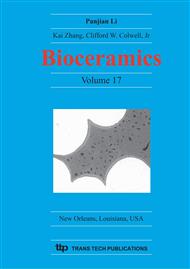p.179
p.183
p.187
p.191
p.195
p.199
p.203
p.207
p.211
Crystallization of Sputtered Hydroxyapatite Films by Hydrothermal Technique and Its Cytotoxicity
Abstract:
Hydroxyapatite (HA) was coated onto titanium substrates using radio frequency sputtering, and the coated HA films were crystallized in an autoclave at 110 °C using a low temperature hydrothermal method. The crystallinity, the Ca/P ratio, and the surface of the films were observed using XRD, EDS, and SEM, respectively. From the XRD patterns, a sputtered film after the hydrothermal treatment had crystallized after 24 h, and the Ca/P ratio decreased from 2.43 ± 0.07 to 1.75 ± 0.11. The growth rate of osteoblast cells was used for cell culture. Among control, titanium and hydrothermally treated film, there was no significant difference in the cell growth rate. However, the growth rate was suppressed on the as-sputtered film.
Info:
Periodical:
Pages:
195-198
Citation:
Online since:
April 2005
Authors:
Keywords:
Price:
Сopyright:
© 2005 Trans Tech Publications Ltd. All Rights Reserved
Share:
Citation:


